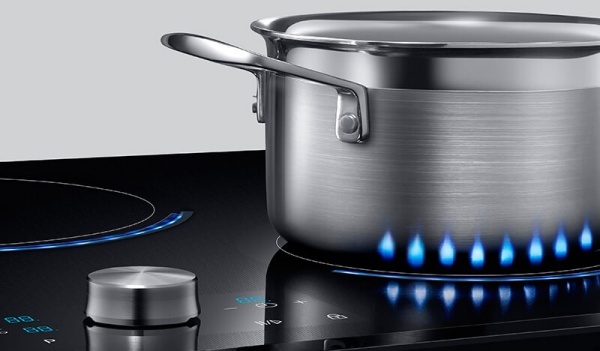
What is Induction Cooking?
Induction technology has been used in cooking since the early 1900s, although it has only recently acquired widespread acceptance in the United States. Manufacturers are currently attempting to create more cost-effective and energy-efficient versions, which are becoming increasingly popular throughout the world.
How do they work?

Induction cookers heat the pans directly without electric or gas-heated elements. Induction cooking employs the use of electric currents to directly heat pots and pans via magnetic induction. Induction warms the cooking vessel nearly instantaneously rather than utilising thermal conduction (a gas or electric element transferring heat from a burner to a pot or pan). To produce heat, an electric current is supplied through a coiled copper wire beneath the cooking surface, creating a magnetic current throughout the frying pan. Because induction does not use a typical outside heat source, the heat transmitted from the pan will only warm the element in use. Because less heat energy is wasted during induction cooking, it is more efficient than standard electric and gas cooking. Although there are no gas and electric-heated elements, induction cookers re able to boil water 50% quicker than other types of stoves. Choosing the perfect induction cooker will surely improve the level of your cooking!
Advantages of an Induction Cooker
Cooks Faster
Because of the electromagnetic cycle’s quick responsiveness, you can cut up to 50% off the normal cook time for many of your favourite recipes. Electromagnetism is used by induction cooktops to stimulate the molecules in your pots and pans. The oscillation of the magnetic field generates heat, which cooks your food. Induction heats up instantly, so your pan will be hot in seconds.
Planet Friendly
Induction cooking consumes less energy since it is quicker than traditional stovetop cooking. It creates practically minimal residual heat (any heat will be in the pot or pan and not coming from the stovetop itself). This results in decreased energy use and cheaper energy costs. Induction also requires less ventilation, making it an excellent choice for city residents or residences where venting outdoors is not available. When it comes to energy efficiency, induction is the obvious victor.
Safer Cooking
Induction employs an electromagnetic reaction to heat the contents of a pan or pot. Throughout the procedure, the burner will be less hot than ordinary electric burners. Within a few minutes of turning off the flame, both the pan and the burner become substantially colder, making burns far less likely. Induction cooktops are clever. Most appliances will shut down automatically if they detect a boilover. Induction warms the cookware, not the glass. This implies that the glass is significantly less prone to create cooking burns.
Lesser Mess
Induction cooktops aren’t the same as radiant electric cooktops. A heating coil beneath the cooking surface of a standard electric cooktop warms the glass, which heats your pan. When you cook, the glass surface becomes quite hot. If you spill on a radiant electric cooktop, you may see scorched rings that are tough to clean over time. Induction is distinct in that the inductors, not the glass, heat up your pan. Although the glass beneath your cookware will be rather heated, you will be less likely to encounter those difficult-to-clean accidents.
Easier to Install
Induction cooktops and ranges are simple to install and may be placed in any room of your home. You may easily replace your old electric range with an induction unit if you have one. Check the parameters to verify your electrical breaker has enough amps. Induction cooktops come in a variety of forms and sizes, and they may be an excellent addition to a guest room, pool house, in-law apartment, or even your home office.
Disadvantages of an Induction Cooker
Expensive
Because induction is still a relatively new technology, an induction cooktop will cost more than a comparable-sized gas or regular electric cooktop.
Needs Special Cookware
If you don’t utilise magnetic cookware, the induction process won’t operate properly and your food won’t cook. This may need the purchase of cookware in addition to the induction cooktop for some.
Electricity Dependent
This is one of the obvious cons of an induction cooker. If there is, by chance, a power interruption then it will be hard for one to cook because the induction cooker will not work, AT ALL.
Can be Noisy
Depending on who you ask, it sounds like a mild buzz, a hum, or a floor fan. This is mainly due to the sort of cookware you use, rather than the stove itself. Cheaper stainless-steel pans can make more noise than heavier cast-iron pans.
Conclusion
Induction cooktops have many advantages over traditional cooking methods. They are faster, more efficient, and safer to use. Induction cooktops also create less mess and are easier to install. The main disadvantage of induction cooking is that it requires special cookware that is not always readily available. Overall, induction cooktops are a great addition to any kitchen.
Last Updated on
- Features to look for in an exhaust fan - September 26, 2022
- How to calculate CFM for exhaust fan - September 24, 2022
- Kitchen Fan Installation – Everything You Need to Know - September 20, 2022
